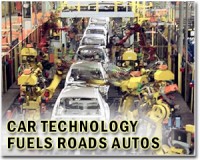 |
Lima (AFP) Dec 3, 2010 Lima's main arteries conjure up a nightmare of traffic snarls and blaring noise for eight million inhabitants of one of Latin America's most clogged, transport-deficient capitals. "Get off! Get on!" bark the bus conductors, known as cobradores, as they chivvy those navigating the capital on a vast fleet of colorful minibuses criss-crossing the city, horns honking. Stuck in the middle of a traffic jam, taxi drivers calmly leaf through newspapers propped on their steering wheels, while Lima chokes on their exhaust fumes. Lima's traffic is a source of stress and bad temper for 60 percent of the population: while 40 percent said it makes them late to work and 75 percent get up a lot earlier to avoid the gridlock, according to a recent study. "Humbly, one must acknowledge Lima is undoubtedly Latin America's most backward capital in matters of transport," said Luis Quispe Candia, president of the Luz Ambar (Code Orange) lobbying group. Luz Ambar has termed the traffic mess a "critical and chaotic situation". Lima grew too fast and is now saddled with a lack of urban planning, investment, project funding, inadequate driver education and weak regulation of the city's estimated 30,000 minibuses and aging car population. Over the past half century, Lima's population has grown six-fold, with a rural exodus peaking in 1980-1990 during the government's crackdown on the leftist Shining Path rebel group that left some 70,000 people dead or missing. Huge imports of used vehicles in the 1990s put many people behind the wheel for the first time and helped expand the city's car population in 20 years from 450,000 to 1.1 million at present. "That's THE problem in Lima; the growing number of vehicles," said Mario Solis, who spends 12 hours a day in his taxi, five of them stuck in traffic. "In the last three years, it's gone exponential," he added, noting with dread that new car registrations had increased by 8.7 percent so far this year. Taxi drivers laugh off the city authorities' feeble stabs at traffic control: this month they imposed fines on jay-walkers, last year, on sounding the horn unnecessarily. A University of Lima study last year found 86 percent of taxi drivers admitted to bribing cops to get out of minor traffic infractions; 40 percent said they did it often -- "three or four times a year" said Mario. People in Lima prefer using the minibuses, which have exploded since public transport was deregulated in the 1990s. They are crowded and often times unsafe, but they are cheaper and, above all, ubiquitous. Lima's challenge, said sociologist Mario Zolezzi, "is having to get around every day while finding a long-term solution" to the traffic nightmare. "The last major investment in transport that made a difference was the Via Expresa (expressway) that bisects Lima 12 kilometers (7.5 miles) north to south and opened in 1972," said Quispe. The opening a few months ago of the Metropolitano, a dedicated long bus route across the city, seems like a good start, but it serves less than 10 percent of Lima's residents for the time being. Bogota has had a similar system for a decade and Curitaba in Brazil for 30 years. The launch of an elevated metro service in Lima's suburbs next year -- 14 years after construction begun -- brings hope of a change. But at that pace, not many in Lima dare to even dream of a proper underground metro line, although preliminary feasibility studies are under way.
Share This Article With Planet Earth
Related Links Car Technology at SpaceMart.com
 Nissan sets December 20 launch date for electric Leaf
Nissan sets December 20 launch date for electric LeafTokyo (AFP) Dec 3, 2010 Nissan on Friday said it will launch the Leaf in Japan on December 20 and days later in the United States as it bets on drivers' readiness to embrace the first globally mass-produced electric car. "We believe this is a true breakthrough and it will serve as a key for mobility of the future," Nissan chief operating officer Toshiyuki Shiga told reporters in Tokyo. "We believe this is the dawn ... read more |
|
| The content herein, unless otherwise known to be public domain, are Copyright 1995-2010 - SpaceDaily. AFP and UPI Wire Stories are copyright Agence France-Presse and United Press International. ESA Portal Reports are copyright European Space Agency. All NASA sourced material is public domain. Additional copyrights may apply in whole or part to other bona fide parties. Advertising does not imply endorsement,agreement or approval of any opinions, statements or information provided by SpaceDaily on any Web page published or hosted by SpaceDaily. Privacy Statement |